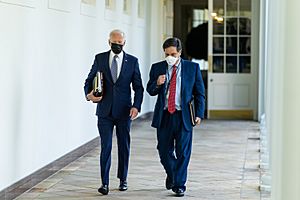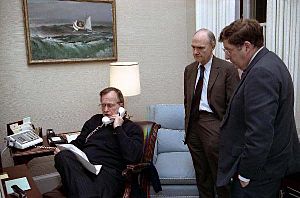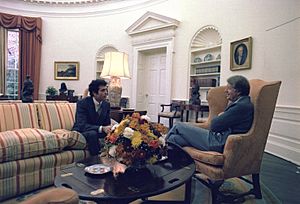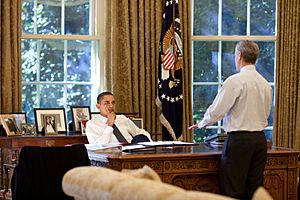White House Chief of Staff facts for kids
Quick facts for kids White House Chief of Staff |
|
|---|---|
 |
|
| Executive Office of the President White House Office |
|
| Reports to | President of the United States |
| Appointer | President of the United States |
| Formation | 1946 (Assistant to the President) 1961 (White House Chief of Staff) |
| First holder | John R. Steelman |



The White House chief of staff is the head of the Executive Office of the President of the United States, a cabinet position in the federal government of the United States.
The chief of staff is a political appointee of the president of the United States who does not require Senate confirmation, and who serves at the pleasure of the President. While not a legally required role, all presidents since Harry S. Truman have appointed a chief of staff.
In the second administration of Donald Trump, the current chief of staff is Susie Wiles, who succeeded Jeff Zients on January 20, 2025. The chief of staff is the most senior political appointee in the White House. The position is widely recognized as one of great power and influence, owing to daily contact with the president of the United States and control of the Executive Office of the President of the United States.
Contents
Historical background
Originally, the duties now performed by the chief of staff belonged to the president's private secretary and were fulfilled by crucial confidantes and policy advisers such as George B. Cortelyou, Joseph Tumulty, and Louis McHenry Howe to presidents Theodore Roosevelt, Woodrow Wilson, and Franklin Roosevelt, respectively. The private secretary served as the president's de facto chief aide, in a role that combined personal and professional assignments of highly delicate and demanding natures, requiring great skill and utmost discretion. The job of gatekeeper and overseeing the president's schedule was separately delegated to the appointments secretary, as with aide Edwin "Pa" Watson.
From 1933 to 1939, as he greatly expanded the scope of the federal government's policies and powers in response to the Great Depression, President Franklin D. Roosevelt relied on his 'Brain Trust' of top advisers. Although working directly for the president, they were often appointed to vacant positions in federal agencies and departments, whence they drew their salaries since the White House lacked statutory or budgetary authority to create staff positions. It was not until 1939, during Roosevelt's second term in office, that the foundations of the modern White House staff were created using a formal structure. Roosevelt was able to persuade Congress to approve the creation of the Executive Office of the President, which would report directly to the president. During World War II, Roosevelt created the position of "Chief of Staff to the Commander-in-Chief" for his principal military adviser, Fleet Admiral William D. Leahy.
In 1946, in response to the rapid growth of the U.S. government's executive branch, the position of "Assistant to the President of the United States" was established. Charged with the affairs of the White House, it was the immediate predecessor to the modern chief of staff. It was in 1953, under Republican President Dwight D. Eisenhower, that the president's preeminent assistant was designated the "White House Chief of Staff".
Assistant to the president became a rank generally shared by the chief of staff along with the other most senior presidential aides such as the White House counsel, the White House press secretary, and others. This new system did not catch on immediately however. Presidents Kennedy and Johnson still relied on their appointments secretaries instead, and it was not until the Nixon administration that the chief of staff took over maintenance of the President's schedule. This concentration of power in the Nixon and Ford White House (whose last chief of staff was Dick Cheney) led presidential candidate Jimmy Carter to campaign in 1976 with the promise that he would not appoint a chief of staff. And indeed, for the first two and a half years of his presidency, he appointed no one to the post.
Average tenure in office
The average tenure for a White House chief of staff is just over 18 months. The inaugural chief of staff, John R. Steelman, under Harry S. Truman, was the president's only chief of staff; Kenneth O'Donnell alone served in the position during John F. Kennedy's unfinished term of 34 months in office. Andrew Card and Denis McDonough each served at least one entire presidential term of office under presidents George W. Bush and Barack Obama, respectively.
Role
Chris Whipple, author of The Gatekeepers: How the White House Chiefs of Staff Define Every Presidency, loosely describes the role of a White House chief of staff through his interview with former president Barack Obama:
During the last days of his presidency, Barack Obama observed: "One of the things I've learned is that the big breakthroughs are typically the result of a lot of grunt work—just a whole lot of blocking and tackling." Grunt work is what chiefs of staff do.
The responsibilities of the chief of staff are both managerial and advisory and may include the following:
- Selecting senior White House staffers and supervising their offices' activities
- Managing and designing the overall structure of the White House staff system
- Control the flow of people into the Oval Office
- Manage the flow of information to and decisions from the Resolute desk (with the White House staff secretary)
- Directing, managing and overseeing all policy development
- Protecting the political interests of the president
- Negotiating legislation and appropriating funds with United States Congress leaders, Cabinet secretaries, and extra-governmental political groups to implement the president's agenda
- Advise on any and usually various issues set by the president
These responsibilities have recently extended to firing of senior staff members. In the case of Omarosa Manigault Newman, who published a tape she alleged was made in the Situation Room of her firing by Chief of Staff John Kelly, the chief of staff said that his decision for her departure was non-negotiable and that "the staff and everyone on the staff works for me and not the president."
Richard Nixon's first chief of staff, H. R. Haldeman, garnered a reputation in Washington for the iron hand he wielded in the position. He was a rigid gatekeeper who would frequently meet with administration officials in place of the president, and then report to Nixon on the officials' talking points himself.
List of White House chiefs of staff
| Image | Name | Start | End | Duration | President | |
|---|---|---|---|---|---|---|
 |
John Steelman | December 12, 1946 | January 20, 1953 | 6 years, 39 days | Harry S. Truman (1945–1953) |
|
 |
Sherman Adams | January 20, 1953 | October 7, 1958 | 5 years, 260 days | Dwight D. Eisenhower (1953–1961) |
|
 |
Wilton Persons | October 7, 1958 | January 20, 1961 | 2 years, 105 days | ||
 |
Kenneth O'Donnell De facto |
January 20, 1961 | November 22, 1963 | 2 years, 306 days | John F. Kennedy (1961–1963) |
|
 |
Walter Jenkins De facto |
November 22, 1963 | October 14, 1964 | 327 days | Lyndon B. Johnson (1963–1969) |
|
 |
Bill Moyers De facto |
October 14, 1964 | July 8, 1965 | 267 days | ||
 |
Jack Valenti De facto |
July 8, 1965 | June 1, 1966 | 328 days | ||
 |
Marvin Watson De facto |
June 1, 1966 | April 26, 1968 | 1 year, 330 days | ||
 |
James Jones De facto |
April 26, 1968 | January 20, 1969 | 269 days | ||
 |
Bob Haldeman | January 20, 1969 | April 30, 1973 | 4 years, 100 days | Richard Nixon (1969–1974) |
|
| Vacant | April 30, 1973 | May 4, 1973 | 4 days | |||
 |
Al Haig | May 4, 1973 | September 21, 1974 | 1 year, 140 days | ||
| Gerald Ford (1974–1977) |
||||||
 |
Donald Rumsfeld | September 21, 1974 | November 20, 1975 | 1 year, 60 days | ||
 |
Dick Cheney | November 20, 1975 | January 20, 1977 | 1 year, 61 days | ||
| Vacant | January 20, 1977 | July 18, 1979 | 2 years, 179 days | Jimmy Carter (1977–1981) |
||
 |
Ham Jordan | July 18, 1979 | June 11, 1980 | 329 days | ||
 |
Jack Watson | June 11, 1980 | January 20, 1981 | 223 days | ||
 |
James Baker | January 20, 1981 | February 4, 1985 | 4 years, 15 days | Ronald Reagan (1981–1989) |
|
 |
Don Regan | February 4, 1985 | February 27, 1987 | 2 years, 23 days | ||
 |
Howard Baker | February 27, 1987 | July 1, 1988 | 1 year, 125 days | ||
 |
Ken Duberstein | July 1, 1988 | January 20, 1989 | 203 days | ||
 |
John Sununu | January 20, 1989 | December 16, 1991 | 2 years, 330 days | George H. W. Bush (1989–1993) |
|
 |
Samuel Skinner | December 16, 1991 | August 23, 1992 | 251 days | ||
 |
James Baker | August 23, 1992 | January 20, 1993 | 150 days | ||
 |
Mack McLarty | January 20, 1993 | July 17, 1994 | 1 year, 178 days | Bill Clinton (1993–2001) |
|
 |
Leon Panetta | July 17, 1994 | January 20, 1997 | 2 years, 187 days | ||
 |
Erskine Bowles | January 20, 1997 | October 20, 1998 | 1 year, 273 days | ||
 |
John Podesta | October 20, 1998 | January 20, 2001 | 2 years, 92 days | ||
 |
Andy Card | January 20, 2001 | April 14, 2006 | 5 years, 84 days | George W. Bush (2001–2009) |
|
 |
Josh Bolten | April 14, 2006 | January 20, 2009 | 2 years, 281 days | ||
 |
Rahm Emanuel | January 20, 2009 | October 1, 2010 | 1 year, 254 days | Barack Obama (2009–2017) |
|
 |
Pete Rouse Acting |
October 1, 2010 | January 13, 2011 | 104 days | ||
 |
Bill Daley | January 13, 2011 | January 27, 2012 | 1 year, 14 days | ||
 |
Jack Lew | January 27, 2012 | January 20, 2013 | 359 days | ||
 |
Denis McDonough | January 20, 2013 | January 20, 2017 | 4 years, 0 days | ||
 |
Reince Priebus | January 20, 2017 | July 31, 2017 | 192 days | Donald Trump (2017–2021) |
|
 |
John Kelly | July 31, 2017 | January 2, 2019 | 1 year, 155 days | ||
 |
Mick Mulvaney Acting |
January 2, 2019 | March 31, 2020 | 1 year, 89 days | ||
 |
Mark Meadows | March 31, 2020 | January 20, 2021 | 295 days | ||
 |
Ron Klain | January 20, 2021 | February 7, 2023 | 2 years, 18 days | Joe Biden (2021–2025) |
|
 |
Jeff Zients | February 8, 2023 | January 20, 2025 | 1 year, 347 days | ||
 |
Susie Wiles | January 20, 2025 | Incumbent | 96 days | Donald Trump (2025–present) |
|
See also
 In Spanish: Jefe de Gabinete de la Casa Blanca para niños
In Spanish: Jefe de Gabinete de la Casa Blanca para niños
- Chief of Staff to the Vice President of the United States
- Chief of staff
- Officer of the United States
- Staff and line
- White House Deputy Chief of Staff




